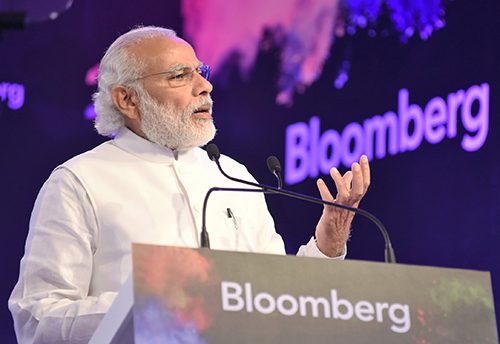In credit ratings upgrades are up and downgrades are down now, said PM Modi
Updated: Mar 29, 2016 07:00:33am

New Delhi, Mar 29 (KNN) In credit ratings, the number of upgrades is 6.8 times the number of downgrades for large firms with low leverage; for medium-sized firms the ratio is 3.9; and for small firms it is 6.3, said Prime Minister Narendra Modi.
PM was addressing at the Bloomberg India Economic Forum, 2016.
He said that there has been a smart pick-up in credit growth after September 2015. Credit off-take between February 2015 and February 2016 increased by 11.5 per cent. The overall fund flow to the corporate sector through equity and borrowings of various kinds, domestic and foreign, has increased in the first three quarters of 2015-16 by over 30 per cent.
“There are some very interesting figures on credit ratings,” Modi said.
In 2013 and 2014, the number of firms whose credit rating was downgraded was much higher than those who were upgraded. That has now changed decisively. Upgrades are up and downgrades are down. In the first half of fiscal year 2015-16, for every company getting a downgrade, there were more than two companies which received upgrades, the best level in recent years, highlighted the PM.
“Among firms with low levels of leverage, the situation is even better. Upgrades exceed downgrades by a huge margin. The number of upgrades is 6.8 times the number of downgrades for large firms with low leverage; for medium-sized firms the ratio is 3.9; and for small firms it is 6.3. These are exceptionally robust numbers,” he said.
The only segment showing an increase in downgrades is highly leveraged large firms.
Modi said that the Government and Reserve Bank have taken tough action to recover dues from large corporate defaulters. Perhaps the noise from this segment has influenced media perceptions.
In a difficult global environment for exports, manufacturing output has fluctuated, he said adding that several key sub-sectors of manufacturing are growing rapidly.
Motor vehicle production, which is a strong indicator of consumer purchasing power and economic activity, has grown at 7.6 per cent. The employment-intensive wearing apparel sector has grown at 8.7 per cent. Manufacturing of furniture has grown by 57 per cent, suggesting a pick-up in sales of flats and houses.
Talking about the major steps taken in the area of generating employment, Modi said, “This is one of my highest priorities. India is a capital scarce, labour abundant country. Yet, the corporate tax structure has favoured capital intensive production.
Tax benefits like accelerated depreciation, and investment allowance have created an artificial bias against labour. Labour regulations have also tended to promote informal employment without social protection, rather than formal employment. We have taken two important steps to change this,” he added.
Firstly, if any firm subject to tax audit increases its work force, it will get a 30 per cent weighted tax deduction on the extra wage cost for three years. Earlier, such a benefit was available only to very few industrial employers and had so many restrictions that it was practically ineffective. It will now cover all sectors including services, for employees with a salary up to 25,000 rupees per month.
Secondly, the Government has taken the responsibility for paying pension contributions for three years for all new persons enrolling in the Employee Provident Fund. This will apply to those with wages up to 15,000 rupees per month. We expect lakhs of the unemployed, and the informally employed, to benefit from these steps.
On progress of the Pradhan Mantri Mudra Yojana , Modi said, “Over 31 million loans have been sanctioned to entrepreneurs for a total value of nearly 19 billion dollars this year.”
As many as 77 per cent of these entrepreneurs are women and 22 per cent of them are from the Scheduled Castes and Scheduled Tribes Even if we assume conservatively that on average, each enterprise creates just one sustainable job, this initiative itself amounts to 31 million in new employment, he said.
The Stand-Up India scheme will also provide 250,000 entrepreneurship loans to women and Scheduled Castes and Scheduled Tribes. (KNN Bureau)












